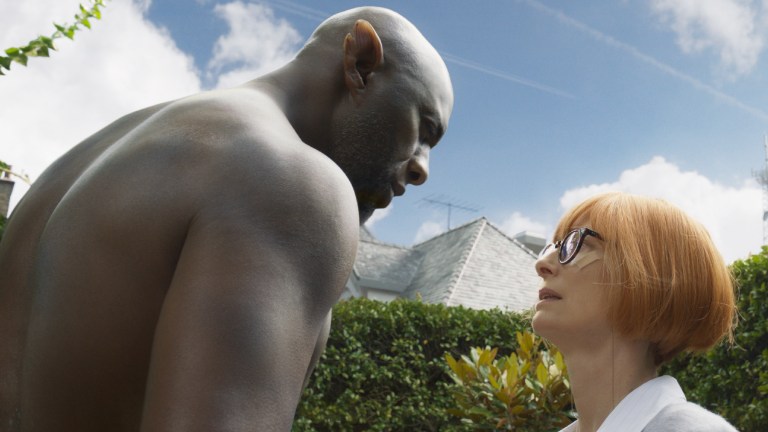Three Thousand Years of Longing Review: George Miller’s Latest Left Turn
Can the Mad Max: Fury Road director Djinn up interest in a fairy tale?

There’s no question that Australian filmmaker and all-around eccentric genius George Miller has had one of the most eclectic directorial journeys in cinema. He’s only directed 10 ¼ features, and out of those, only three are standalone films (the quarter-feature, by the way, is the “Nightmare at 20,000 Feet” segment in 1983’s The Twilight Zone: The Movie, easily the best portion of the film). Four of his movies comprise perhaps the greatest post-apocalyptic action series of all time, while three more are…part of beloved and/or successful children’s franchises. It’s an odd resume, to say the least.
Which brings us to his latest venture, Three Thousand Years of Longing, based on the novella “The Djinn in the Nightingale’s Eye” by A.S. Byatt. Following his 2015 masterpiece, Mad Max: Fury Road, the new film is about as far away from that visceral, high-octane desert epic as one could get, especially since it largely takes place between two characters in one hotel room. Of course, one of those characters is a Djinn, played with majesty, empathy, and tremendous compassion by Idris Elba, so the film isn’t exactly a sitting room two-hander.
The other character, played by Tilda Swinton, is Dr. Alithea Binnie. A professor of “narratology” – the study of stories and narrative structure throughout history – Alithea seems happy in life, engaged with her work, and enjoys her travels and the company of friends. Out shopping while at a conference in Istanbul, she purchases an exotic glass bottle, and once she gets it back to her room, she inadvertently releases the Djinn inside, who of course offers her three wishes in exchange for his freedom.
Alithea’s initial reaction to the Djinn’s appearance is natural: she thinks she’s going mad. But once she ascertains that he’s actually real, she also realizes that her skills are especially useful in this scenario: she’s well-versed in the many stories throughout the ages of wishes gone bad and wishes ill-conceived. So she delays making her own, demanding that the Djinn tell her his story first – a millennia-spanning tale of love, loss, and grief that eventually makes Alithea realize what she may really want.
Where Miller’s reputation for visual panache comes into play is the recounting of the Djinn’s long, turbulent, and often lonely life, as he first loses the great love of his life, is sealed in his bottle by the man who claims her, and is then freed and recaptured repeatedly in different cities, in different countries, and at different times throughout the ancient Middle East.
The three main stories that the Djinn shares with Alithea all involve his attempts to help women, and all are drenched in luscious, colorful, and frequently bizarre details that both accentuate the mythological aura of the Djinn’s experiences as well as the rich emotion bursting within them – the latter an aspect that the academic, buttoned-up Alithea has overlooked in her own studies. Although the visual splendor is surprisingly taken down a peg by some subpar CG work (a disappointment coming from Miller), the stories themselves are captivating, as is the Djinn’s telling of them.
Eventually the movie settles into how the narratives of Alithea and the Djinn ultimately intertwine, at first through their shared love of storytelling. But it’s in the latter stages where the movie falters, the sweep of the previous tales that the Djinn spins giving way to a more prosaic and thematically hazy ending that seems almost if the film just stops rather than coming to a climax.
Still, while its technical weaknesses and those latter-stage narrative letdowns prevent Three Thousand Years of Longing from being perhaps the great, visionary film we’d all like to see from Miller, there are enough pleasures here – in the performances, the stories, and the movie’s ambition — to keep one interested most of the way through its leisurely-paced 108 minutes.
Chief among those are Elba and Swinton, of course. Elba powerfully conveys the anguish, loneliness, and occasional ecstasy of the Djinn’s long and often painfully lonely life, his natural presence working well with some choice visual effects to enhance the character’s supernatural existence while also never forgetting to emphasize the humanity and romance in his heart.
Swinton has, in some ways, the more difficult role: she is the foil and occasional naysayer to the Djinn’s flights of storytelling fancy, and Alithea by design is the harder character to warm up to – but one eventually does, thanks to her skillful work and the way that the movie gently peels back her exterior armor to reveal the wounded, deeply loving person inside.
If one is perhaps left longing – pardon the expression – for a more emotional crescendo to the events of the film, that’s due more to the unusual nature of the screenplay itself (essentially the frame for an anthology of folk tales) than the work by the two main actors or the breathtaking imagery of much of the film.
In the end, Three Thousand Years of Longing is about how we reveal ourselves through the stories we tell: what Miller reveals here – in halting but still compelling fashion — is that he still believes in the power of such stories, and their ability to tell us something about the human heart.
Three Thousand Years of Longing opens in theaters this Friday (August 26).
